Physical Address
1/1-3B, Siva Nagar, 100 Feet Road, Kovai Pudur, Coimbatore, Tamilnadu - 641042, India
Physical Address
1/1-3B, Siva Nagar, 100 Feet Road, Kovai Pudur, Coimbatore, Tamilnadu - 641042, India

Avoid these common pitfalls and build your startup on a smarter foundation.
Choosing the right tech stack is one of the most critical early decisions a startup founder makes. It determines your product’s speed, scalability, development cost, and how easy it is to maintain or hire for.
But too often, new founders — especially non-technical ones — make decisions based on trends, hype, or bad advice. In this post, we’ll break down the 5 most common mistakes founders make when selecting their tech stack (and how to avoid them).
—
⚠️ Mistake 1: Choosing What’s Popular, Not What’s Practical
Just because everyone’s talking about Rust, Go, or a fancy front-end framework doesn’t mean it’s right for you.
Example: A small MVP doesn’t need bleeding-edge architecture. It needs to launch fast and validate an idea.
🚫 Wrong approach: “Let’s use the hottest stack from Hacker News.”
✅ Better approach: “What’s simple, well-supported, and gets us to launch quickly?”
🧠 Tip: Proven stacks like MERN (MongoDB, Express, React, Node) or Laravel + MySQL are great for MVPs.
—
⚠️ Mistake 2: Ignoring Developer Availability
You may pick a stack that looks good on paper — but if you can’t hire or afford developers who know it, you’re in trouble.
Example: You choose Elixir or Svelte because it’s cool, but struggle to find talent or freelancers.
🚫 Wrong assumption: “A good dev can learn anything.”
✅ Better strategy: “Let’s use tech with a large, affordable talent pool.”
🧠 Tip: Languages like JavaScript, Python, and PHP have global communities and easier hiring options.
—
⚠️ Mistake 3: Overengineering the MVP
New founders often try to build for scale too early: microservices, Kubernetes, serverless orchestration — all before having a single user.
You’re solving problems you don’t yet have.
🚫 Mistake: “We want to scale like Uber.”
✅ Smarter mindset: “Let’s scale only when the product and demand require it.”
🧠 Tip: Build a monolith first. Focus on features, feedback, and iteration — not infrastructure.
—
⚠️ Mistake 4: Ignoring Long-Term Maintainability
A flashy stack might help you build fast, but if it’s hard to test, debug, or onboard new devs, it becomes expensive over time.
Ask yourself:
🚫 Mistake: “It works for now.”
✅ Best practice: “Let’s choose something future-proof and understandable.”
🧠 Tip: Use a style guide, proper folder structure, and documentation from day one — regardless of stack.
—
⚠️ Mistake 5: No Consideration for Integration or Ecosystem
Your product won’t exist in a vacuum. You’ll eventually need APIs, payment systems, analytics, or email tools.
Some stacks have better integrations than others.
🚫 Mistake: “We’ll worry about that later.”
✅ Smart move: “Let’s make sure our stack plays well with Stripe, Firebase, SendGrid, etc.”
🧠 Tip: Choose platforms with rich SDKs, plug-ins, and documentation to avoid rebuilding wheels.
—
🎯 Final Checklist for Choosing a Tech Stack
Before you decide, ask:
—
🧠 Founder-Friendly Stack Examples (2025 Edition)
| Use Case | Suggested Stack |
|---|---|
| SaaS MVP | Node.js + Express + PostgreSQL + React |
| Mobile-first App | React Native or Flutter + Firebase |
| Internal Tools / Dashboards | Django + PostgreSQL + HTMX |
| Static Content + Landing | Next.js + Vercel + Tailwind CSS |
| No-code prototype | Bubble or Glide (for testing ideas fast) |
—
💬 Conclusion
Choosing your startup’s tech stack doesn’t need to be overwhelming. Focus on speed, simplicity, talent availability, and future flexibility. Avoid overengineering — and remember, your stack should serve your product, not the other way around.
Let tech help you build smarter — not slower.
555winpg? Okay, I tried it out. Not gonna lie, it’s got some interesting stuff. Worth exploring if you’re bored with everything else. Check it out: 555winpg
Goal11casino caught my eye with their promotions. Gave it a spin, and the platform is smoother than I expected. Worth a shot if you’re looking for something new to play. Check it out here: goal11casino